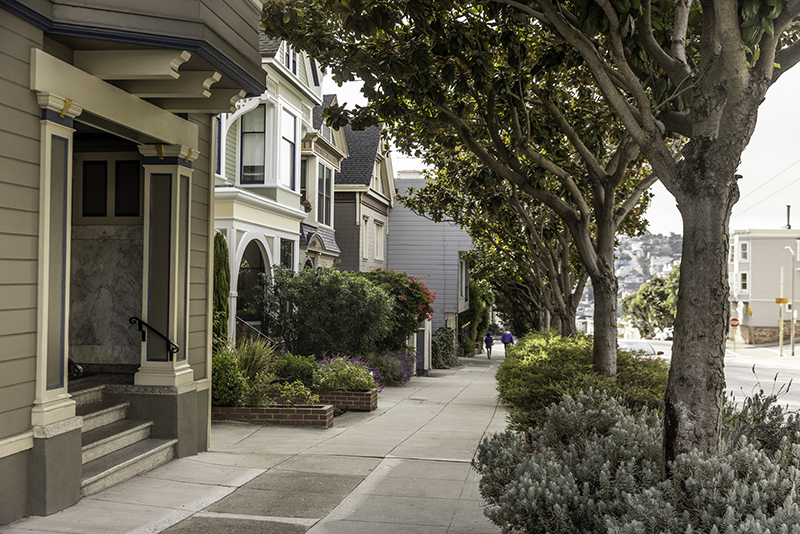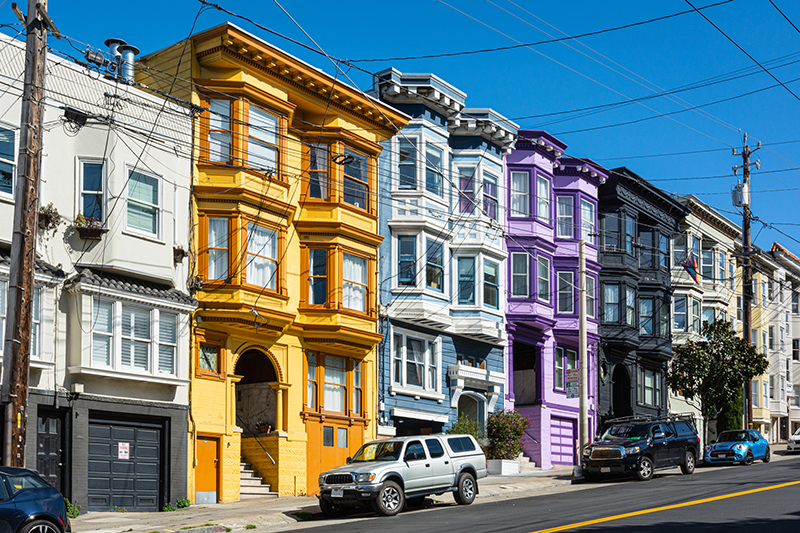
Also known as “The Sunny Heart of San Francisco,” Eureka Valley offers a diverse range of real estate options in a vibrant setting. If you’re looking for a home in this coveted area of San Francisco, here are some general tips for first-time homebuyers.
Table of Content
UNDERSTANDING EUREKA VALLEY REAL ESTATE

Eureka Valley is a desirable residential area encompassing the Castro, Corona Heights, Dolores Heights, and Duboce Triangle.
-
The Castro District, simply known as the Castro, holds a special place in the American gay rights movement. It has a historic theater, exciting nightlife, and trendy shops and restaurants. While the Castro is best known for being an LGBTQIA+ friendly community, its population is quite diverse and includes many young families.
-
Corona Heights encompasses the area between Buena Vista Park and Eureka Valley. Located north of Market Street, some locals consider it part of the Castro District and Upper Market. Its streets were fashioned out of a large hill that once stood on Buena Vista Park and extended to Market Street.
-
Dolores Heights borders the Castro District to the north. It is best known for its hilly and scenic landscape with steep staircases and quiet cul-de-sacs. It gets less fog and more sunshine than other places in San Francisco as it is shielded by the Twin Peaks.
-
The Duboce Triangle is situated below Buena Vista Park and between the Castro/Eureka Valley, Mission District, and Lower Haight.
First settled by Europeans in the mid-19th century, Eureka Valley was formerly part of Mission Dolores and a Mexican ranch. Once a rural area, it transformed into a bustling streetcar suburb with the opening of the Market & Castro Street Cable Car line in 1886. Much of the modern development in Eureka Valley took place in the 1890s and early 1900s with the construction of two-story flats and wood-frame cottages.
It survived the 1906 earthquake and fire mostly intact and harbors many historic properties today. The area witnessed demographic shifts and increased urban decentralization in the years following World War II. It became associated with the gay movement in the 1960s and 1970s.
Today, Eureka Valley is a thriving urban district with commercial developments, civic institutions, and first-class city services. Bordered by Market Street, the neighborhood is centrally located and offers direct freeway access. It is also served by Muni Metro and buses.
The Eureka Valley housing market
As a historically significant neighborhood, Eureka Valley offers some of the finest historic homes in San Francisco. These include some of the earliest surviving homes to sites tied to LGBTQIA+ history of the last quarter century. Buyers will also find new infill residential developments in the area. From single-family homes to condos and multi-family buildings, there’s something for everyone in this neighborhood.
Known for its hilly areas, tree-lined streets, spectacular views, and spacious properties, Eureka Valley continues to be one of San Francisco’s most coveted addresses. While real estate trends fluctuate over time, Eureka Valley typically has low inventory, with buyer demand outpacing the number of available homes. It is not uncommon for the most desirable homes to sell quickly, with sellers receiving multiple offers. This has created upward pressure on home prices, which are among the highest in the United States.
The median listing price is $1.7 million as of August 2023 – up 4.1% year-over-year. The median sale price is $1.5 million, according to data from Realtor.com. The demand for homes is primarily driven by tech buyers, who are drawn to Eureka Valley because of its convenient location and stunning Victorians and Edwardians.

TIPS FOR FIRST-TIME HOMEBUYERS
There are many ways for first-time buyers to secure their dream home in Eureka Valley despite intense competition and higher home prices. Here are some basic tips for first time home buyers.
-
Set a budget
When setting a budget for a home purchase, it helps to conduct a thorough assessment of your current financial situation, including your income, debt, and savings. This will help you evaluate your financial preparedness and determine the next steps in getting ready to buy your first home.
Knowing how much you can afford will help guide the search process and make it easier to identify properties in your price range. Be realistic about how much you comfortably afford and be flexible when making an offer. Instead of sticking to a fixed budget, it would make more sense to set a price range and decide which properties are worth the high end of this range based on size, features, and location.
Getting pre-qualified for a mortgage is typically one of the first steps to buying a home, unless you plan on making a cash offer. Pre-qualification will give you a rough estimate of how much you can borrow based on your income, credit score, debt-to-income ratio, and other factors.

In general, making a down payment of about 20% or higher will help you avoid having to pay for private mortgage insurance (PMI), which can increase your monthly expenses. In addition to home prices, it is also important to account for closing costs, which are typically 2% to 5% of the purchase price. Closing costs often include appraisal, inspection, and legal fees.
The costs of homeownership go beyond the purchase price and transaction fees. Long-term costs include property taxes, home insurance, and homeowners association (HOA) fees, if applicable. These costs can have a significant impact on your monthly payments. Research property taxes ahead of time and crunch the numbers before making an offer. Get quotes from several insurance providers and compare rates.
It is also advisable to establish an emergency fund for unexpected expenses, such as major repairs or replacements, after purchasing a home. Set enough money aside for property maintenance. As a general guide, housing expenses should not consume more than 30% of your monthly income. However, it is also important to keep in mind that the ongoing costs of homeownership may be higher in an expensive city like San Francisco.
-
Know your goals
Buyers have different reasons for wanting to become homeowners. Knowing your motivations for buying will help you make informed decisions and stay focused on your goals. Some of the most common goals around homeownership include:
-
Stability. For some, homeownership creates a sense of stability and security. Many buyers want to have a permanent place to live and get out of the uncertainty of renting and frequent relocation. Homeownership is also considered an important milestone in adulthood and creates a sense of accomplishment.
-
Personalization. Homeowners can decorate, paint, and renovate their home to their liking. This gives them the opportunity to design a living space that truly reflects their taste and preferences. The right property can also help them pursue their hobbies and interests, such as gardening, cooking, collecting, arts and crafts, and more.
-
Equity. Homeowners can build equity as they make mortgage payments over time. Equity can serve as a precious resource that can be used later on for investments and other financial ventures.
-
Passive income. Many buyers look for property that they can rent out, either fully or partially, with the goal of generating passive income and building their personal wealth.
-
Appreciation. Real estate is typically considered a stable long-term investment. Many homeowners hope that their property will appreciate in value over time, which can create a potential for sizable profits if they decide to sell later on.
-
Savings. Depending on market rates and conditions, buying can be more cost-effective than renting a home in the long run. This is because monthly mortgage payments can go toward building equity instead of paying rent to a property investor.
-
Retirement. Many buyers want to own a home with retirement in mind. They want to pay off their mortgage in time for retirement so that they can keep their living expenses manageable and have a secure place to stay in the future.
Taking a goal-oriented approach to the buying process is one of the most underrated tips for first time home buyers. Knowing your reasons for buying will help you stay grounded should the transaction become stressful down the road.
-
-
Know your mortgage options
Conventional and jumbo mortgages are issued by lenders in the private sector, usually the banks. Conventional loans are the most common mortgage type in the United States. This loan conforms to conventional loan limits and caters to the needs of the average homebuyer.
Jumbo mortgages, on the other hand, exceed conventional loan limits and are used to buy homes with higher prices – typically luxury real estate or larger properties worth millions of dollars.
Government-backed mortgages are backed by agencies such as the Federal Housing Administration (FHA), Department of Veterans Affairs (VA), and Department of Agriculture (USDA). These loans are meant to help eligible buyers qualify for a loan and make homeownership more accessible.
Other loan types to be aware of include:
-
Fixed-rate mortgages. This loan type is ideal for buyers who prefer a certain level of predictability and pay the same amount for the duration of the mortgage since the interest rate will remain fixed.
-
Adjustable-rate mortgages. When availing an adjustable-rate mortgage, the buyer’s monthly payments will fluctuate along with market and national interest rates. In most cases, lenders will offer the borrower a fixed rate for the first few years of the mortgage before the adjustable rate comes into play and rates become subject to changes every six months or so. This mortgage type is ideal for buyers who do not plan to hold onto their homes for very long.
For more information on mortgage products, consult with a lender in your area.
-
-
Work with a local Realtor

Working with a local expert is one of the most important tips for first-time homebuyers in a dynamic market like Eureka Valley. An experienced Realtor will provide valuable expertise and professional guidance throughout the buying process. Their market knowledge will help you gain insight into real estate trends, home prices, property values, neighborhoods, schools, and amenities. Working with a Realtor will help you save money by avoiding costly mistakes and knowing a home’s correct price.
A Realtor can also help expand your search and increase your chances of finding a suitable property by providing access to Multiple Listing Services (MLS), a comprehensive database containing active listings in a given area. They can also reach into their network to find exclusive and off-market listings that match your criteria.
Lastly, Realtors are expert negotiators who will protect your interests when discussing the sale price, contingencies, closing date, and other terms. They will help you secure the best possible deal.
-
Research property types and neighborhoods
Expanding your knowledge on property types and communities in Eureka Valley will help you make informed decisions that support your goals, needs, and preferences as a buyer. Choosing the right property will help improve your quality of life and move forward with your long-term financial goals. Moving to the right neighborhood will also give you a sense of belonging and keep your home’s property value robust over time.
Before making an offer, get to know the inner workings of the home by requesting a thorough home inspection. This will help you uncover any issues with its structure and components. Determine the most suitable property type – single-family, multi-family, or condo – based on how you expect your household and family life to evolve over time.
It is also important to learn everything you can about the neighborhood and the surrounding areas, particularly when it comes to noise level, traffic, and planned developments that can potentially affect your usage and enjoyment of the property. Talk to the neighbors and visit the neighborhood at different hours or days of the week to get a better feel for the place.
-
Browse listings
Once you’re financially prepared and well-informed about the local market, you can start browsing listings and viewing properties. It’s easy to get carried away when house hunting, which is why it is important to stay focused on your goals and make decisions based on relevant market data, home inspection reports, and other facts.
It is also important to be strategic about planning and scheduling home viewing appointments. Viewing too many properties can be time-consuming and might make it more difficult to make a decision, while looking at very few listings will prevent you from exploring your best options in the market.
EXPLORE OTHER SAN FRANCISCO NEIGHBORHOODS
FIND HOMES FOR SALE IN EUREKA VALLEY TODAY
If you have your heart set on living in Eureka Valley, work with a trusted Realtor who will support you throughout the buying process. Let me, Dave Cunningham, help you find the perfect home in this desirable area of San Francisco. As a full-time Realtor and top producer with over 23 years of experience, I will help you navigate the complexities of the Eureka Valley housing market.
With local expertise and strong negotiation skills, I specialize in multi-unit buildings, real estate investments, and 1031 exchanges. My knowledge of San Francisco’s finest neighborhoods is unsurpassed.
I can’t wait to help you explore Eureka Valley real estate and everything that the neighborhood has to offer in terms of lifestyle and community. Please contact me at 415.244.4779 or send an email here.
